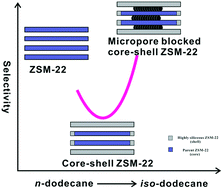Micropore blocked core–shell ZSM-22 designed via epitaxial growth with enhanced shape selectivity and high n-dodecane hydroisomerization performance†
Abstract
A core–shell ZSM-22 (Z@S) was synthesized via epitaxial growth. The characterization results of Z@S validated that the acid sites located on the external surface of core ZSM-22 were passivated by the epitaxial shell of highly siliceous ZSM-22 and the acid strength of ZSM-22 remained unchanged. For comparison, highly siliceous and boron-containing ZSM-22 were also synthesized and characterized. In n-dodecane hydroisomerization, highly siliceous ZSM-22 almost without acid sites at the external surface achieved a much higher iso-dodecane selectivity than boron-containing ZSM-22 with weak acid sites. Z@S with strong acid sites and passivated surface acidity showed high activity and favored pore mouth catalysis but exhibited a lowered iso-dodecane selectivity. The reduced external surface acid sites enhanced the diffusion of n-alkane into the micropores, leading to severe cracking reaction caused by acid sites on the internal surface. Further modifying Z@S via micropore blockage could greatly inhibit cracking reaction inside the micropores and confine isomerization at the pore mouth of ZSM-22. This new ZSM-22 catalyst achieved higher activity and a higher iso-dodecane yield than catalysts with weak acidity.

- This article is part of the themed collection: 2018 Catalysis Science & Technology HOT Articles


 Please wait while we load your content...
Please wait while we load your content...